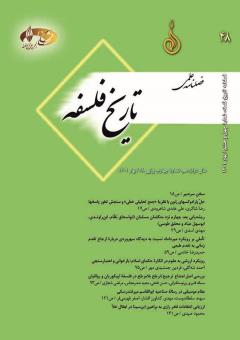ریشهیابی بعد چهارم نزد متکلمان مسلمان (ابواسحاق نظّام، ابنراوندی، ابوسهل عبّاد و محقّق طوسي)
محورهای موضوعی : ریشهشناسی مکاتب و آراء فلسفی در ادوار قدیم و جدید
1 - استادیار فلسفة اسلامی و حکمت معاصر، پژوهشگاه علوم انسانی و مطالعات فرهنگی، تهران، ایران
کلید واژه: چهاربعدگروی, زمان, ثبوت معتزلی, نظّام, ابنراوندی, عبّاد, محقّق طوسی,
چکیده مقاله :
بُعد چهارم از مسائلی است که مرزهای فلسفه را درنوردیده و امروزه یکی از دغدغههای اصلی فیزیکدانهاست. با این حال، پیشینه و تاریخچة دقیق اين ديدگاه هنوز در هالهيی از ابهام است. در فلسفة غرب، بعد چهارم را با تکلّف در آراء برخی از اندیشمندان غربی سدههای میانه، مانند آنسلم، ریشهیابی کردهاند؛ با آنکه هیچ عبارت صریحی در اینباره در آثار آنها وجود ندارد. در جامعة فلسفی کشور ما نیز بعد چهارم تا ملاصدرا ریشهیابی شده است. هدف اين نوشتار آنست كه نشان دهد در جهان اسلام پیش از ملاصدرا، در آثار خواجه نصيرالدين طوسي عبارتهای کاملاً صریحی در اينباره وجود دارد. پیش از طوسی نیز گرچه عبارت آشكاري در منابع دست اوّل نیافتیم، ولي در منابع دست دوّم به برخی از متکلمان جهان اسلام، ازجمله نظّام، ابنراوندی و عبّاد، سخنانی نسبت داده شده است که محتوای آن چیزی جز چهاربعدگروی نیست. این مقاله بروش تاریخی، دیدگاههای اين اندیشمندان را گردآوری کرده و به تحلیل عقلی آنها خواهد پرداخت.
The fourth dimension is one of the problems that have left the borderlines of philosophy behind and are now among the main concerns of physicists. However, the accurate background and history of this view are still clouded. The roots of the fourth dimension can be traced back to the works and ideas of some thinkers of the Middle Ages, such as Anselm, in Western philosophy, although there is no explicit reference in this regard in their works. The roots of the fourth dimension have also been found in the works of Mullā Ṣadrā in Iranian philosophical society. This paper aims to demonstrate that there are some clearly explicit statements about the fourth dimension in the works of Khwājah Naṣīr al-Dīn Ṭūsī in the Islamic world before Mullā Ṣadrā. The author has found no direct statement in this respect in first-hand sources; however, some ideas have been attributed in second-hand sources to some of the mutikallimūn of the Islamic world, including Naẓẓām, Ibn Rāwandī, and ‘Abbād, that focus on four-dimensionalism. Following a historical approach, this paper has compiled the views of these thinkers and analyzed them based on a rational approach.
آگوستین (1381) اعترافات، ترجمة سایه میثمی، تهران: دفتر پژوهش و نشر سهروردی.
ابن أبيالحديد (1378ق) شرح نهج البلاغة، ج3، تحقیق محمد ابوالفضل ابراهیم، بیروت: دار احیاء الکتب العربیة.
ابن النديم (1417ق) الفهرست، تحقيق إبراهيم رمضان، بيروت: دار المعرفة.
ابنحزم (1416ق) الفصل فی الملل و الأهواء و النحل، ج3، بيروت: دار الکتب العلمية.
ابنمتويه (1986م) کتاب المجموع فی المحيط بالتكليف، ج2، عني بتحقيقه و نشره: جين يوسف هوبن، راجع التحقيق و استدركه دانيال جيماريه، بيروت: دار المشرق.
ابنمتويه (1975م) التذكرة فی أحكام الجواهر و الأعراض، تحقيق و تقديم سامي نصر لطف و فيصل بدير عون، تصدير إبراهيم مدكور، القاهرة: دار الثقافة.
اشعري، أبوالحسن (۱۴۰۵ق) مقالات الاسلاميين و اختلاف المصلين، تصحیح محمد محییالدین عبدالحمید، قاهره.
اقبال آشتیانی، عباس (1345) خاندان نوبختی، تهران: طهوری.
بغدادى، عبدالقاهر بن طاهر (1408ق) الفرق بين الفرق و بيان الفرقة الناجية منهم، بيروت: دار الجيل.
بلخی، ابوالقاسم (1439ق) کتاب المقالات و معه عیون المسائل والجوابات، تصحيح حسین خانصر، راجح کردی و عبدالحمید کردی، ترکیه: کورامر.
جوادى آملى، عبدالله (1378) تسنيم: تفسير قرآن كريم، ج1، قم: اسراء.
حلبى، على اصغر (1376) تاريخ علم كلام در ايران و جهان، تهران: اساطير.
خیّاط، ابوالحسین (2004م) کتاب الانتصار و الرد علی ابن الراوندی الملحد، تحقيق هنریک ساموئل نیبرج، جبیل (لبنان): دار و مکتبة بيبليون.
رازی، فخرالدین (1407ق) المطالب العالية فى علم الكلام، ج4، بیروت: دار الکتاب العربي.
شهرستانی، محمد بن عبدالكريم (1364) الملل و النحل، ج1، تحقيق محمد بدران، قم: الشريف الرضي.
طوسي، نصيرالدين (1359) تلخیص المحصّل، به اهتمام عبدالله نورانی، تهران: دانشگاه تهران.
طوسي، نصيرالدين (1375) شرح الاشارات و التنبيهات، ج2، قم: نشر البلاغة.
قاضى عبدالجبار (1422ق) شرح الأصول الخمسة، بيروت: دار احياء التراث العربي.
قاضى عبدالجبار (1971م) المختصر فی أصول الدين، تحقيق محمد عمارة، بيروت: دار الهلال.
قاضى عبدالجبار (1972م) المنية و الأمل، تحقيق سامى نشار و عصامالدين محمد، اسكندريه: دار المطبوعات الجامعية.
قاضى عبدالجبار (1965م) المغنی فی أبواب التوحيد و العدل، رؤية الباری، ج4، تحقیق محمد مصطفی حلمی و ابوالوفا الغنیمی، مراجعه ابراهیم مدکور، قاهره: المؤسسة المصرية العامة للتأليف والأنباء والنشر.
گذشته، ناصر (1384) «اندیشههای تنزیهی عباد بن سلیمان»، مقالات و بررسیها، شمارة پیاپی 597، ص254-247.
معري، ابوالعلاء (1397ق) رسالة الغفران، تحقیق و شرح عائشه عبدالرحمان، قاهره: دار المعارف.
ناشناس (1385) شرح كتاب التذكرة فی أحكام الجواهر و الاعراض ابن متويه، چاپ عكسى از روى نسخۀ خطى كتابخانۀ شادروان اصغر مهدوى، تاريخ كتابت ٥٧٠ هـ . ق، پیشگفتار فارسی از نصرالله پورجوادی، مقدمۀ انگلیسی و فهرستها از زابینه اشمیتکه، تهران: مؤسسة پژوهشى حكمت و فلسفه ايران.
هاروني، ابوطالب (2011م) زيادات شرح الأصول (طوالع علم الكلام المعتزلی، كتاب الأصول لابی علی محمد بن خلاد البصري وشروحه: طبعة محققة لزيادات شرح الأصول)، كاميلا آدانغ ولفرد مادلنغ زابينا اشمدتكه، لیدن: بریل.
